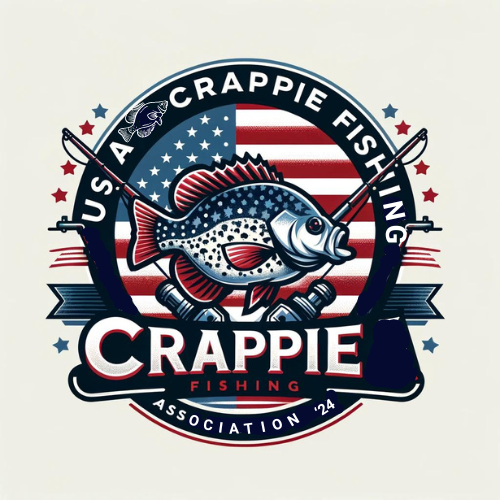In order to maximize your success in crappie fishing, it’s crucial to optimize your crappie setup, which includes the right fishing gear and techniques. By understanding the fundamentals of crappie fishing, you can increase your chances of a productive and rewarding fishing trip. Whether you’re a beginner or an experienced angler, this article will provide you with valuable information to enhance your crappie fishing setup.
Key Takeaways:
- Choosing the right crappie fishing rod and reel is essential for a successful setup.
- Selecting the appropriate fishing line ensures the right balance of strength and visibility.
- Deciphering crappie lures and baits can greatly improve your chances of attracting bites.
- Adapting your techniques to different conditions can help you optimize your crappie fishing setup.
- There are budget-friendly options available for crappie fishing gear without sacrificing quality.
Understanding the Basics of Crappie Fishing Setup
A successful crappie fishing setup requires a balance between sensitivity and strength. When it comes to crappie fishing, these elusive fish can be picky eaters and their bites can be incredibly subtle. Therefore, having a setup that allows you to feel even the slightest nibble while still providing enough strength to reel in your catch is essential.
Being able to sense the underwater terrain and locate crappie hotspots is the key to a successful fishing trip.
Sensitivity plays a crucial role in your crappie fishing experience. With the right setup, you’ll be able to detect the smallest movements and vibrations, helping you identify the presence of crappie in the surrounding area. Additionally, sensitivity allows you to understand the underwater structure, such as submerged trees, grass beds, and drop-offs, where crappie tend to congregate.
Choosing the Right Rod
One of the first steps in setting up your crappie fishing gear is selecting the right rod. A lightweight and highly sensitive rod is ideal for detecting the faintest bites. Look for a rod that is specifically designed for crappie fishing, such as the Shimano Expride Spinning Rod or the St. Croix Panfish Series Rod. These rods are known for their excellent sensitivity and responsiveness.
Picking the Right Line
Equally important is choosing the right fishing line. Opt for a low-stretch monofilament or fluorocarbon line with a pound test that matches the size of the crappie you’re targeting. Lines like the Berkley Trilene XL or the Seaguar Blue Label Fluorocarbon are popular choices among experienced crappie anglers.
| Line Type | Diameter (in pounds) |
|---|---|
| Monofilament | 4-8 |
| Fluorocarbon | 4-8 |
Using a thin line diameter will enhance the sensitivity of your setup, making it easier to detect bites and feel the movement of your bait. Additionally, a thinner line sinks faster, allowing your bait to reach the desired depth quickly.
Go Light on the Hooks
When it comes to hooks, opt for smaller sizes in the range of #6 to #2. Crappie have delicate mouths, and using smaller hooks will increase your hook-up ratio. Brands like Gamakatsu and Mustad offer a wide range of hooks specifically designed for crappie fishing.
Remember, the right crappie fishing setup is all about finding the perfect balance between sensitivity and strength. By paying attention to the details and choosing the right equipment, you’ll be well-prepared to tackle the exciting challenges of crappie fishing.
Choosing the Right Crappie Fishing Rod
When it comes to crappie fishing, selecting the right rod is essential for a successful fishing experience. Factors such as rod length and material play a crucial role in determining your casting accuracy and your ability to handle the fight of a crappie. Let’s explore the key considerations for choosing an ideal crappie fishing rod.
Rod Length: Finding the Perfect Balance
The length of your crappie fishing rod greatly influences your casting distance and control on the water. Typically, a rod around 7 to 9 feet in length is recommended for crappie fishing. This length provides an optimal balance between casting accuracy and maneuverability.
A longer rod allows you to make longer casts, which can be advantageous when fishing in open water or targeting crappie in deeper areas. On the other hand, a shorter rod offers more control and is ideal for fishing in tight spots or areas with heavy cover.
Ultimately, the choice of rod length depends on your fishing preferences and the specific conditions of your fishing location.
Rod Material: Lightweight and Sensitive
The material of your crappie fishing rod has a significant impact on its overall performance. Graphite is a popular choice among anglers due to its lightweight and sensitivity.
Graphite rods offer excellent sensitivity, allowing you to feel even the slightest nibbles from crappie. This heightened sensitivity helps you detect bites more easily and increases your chances of a successful hookup.
In addition to sensitivity, graphite rods are also lightweight, making them comfortable to handle for extended periods. The reduced weight allows for faster rod movements, better accuracy, and less fatigue during long fishing sessions.
Other rod materials, such as fiberglass, are also available and offer their own unique advantages. However, for crappie fishing, graphite rods are widely preferred for their optimal combination of sensitivity and lightweight design.
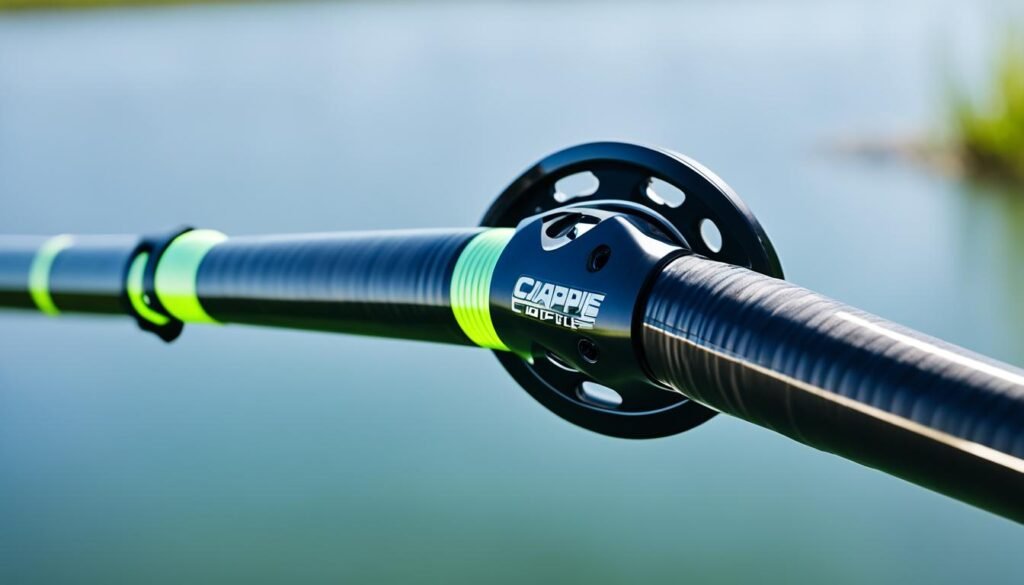
The Importance of Rod Power and Action
In addition to rod length and material, it’s important to consider the power and action of your crappie fishing rod. Power refers to the rod’s resistance and its ability to handle different fish sizes. For crappie fishing, a medium-light to ultra-light power rod is recommended.
A medium-light power rod provides enough strength to handle the fight of a decently-sized crappie while still maintaining sensitivity for detecting bites. An ultra-light power rod, on the other hand, offers maximum sensitivity, making it ideal for targeting smaller or finicky crappie.
The action of a fishing rod refers to its stiffness or flexibility. Fast action rods flex primarily at the tip, providing quick responsiveness and greater control. Slow action rods, on the other hand, flex throughout their length, allowing for a more parabolic bend.
For crappie fishing, a fast or medium-fast action rod is recommended. These actions offer the right balance of sensitivity, control, and hook-setting power needed for a successful crappie fishing excursion.
Summary
Choosing the right crappie fishing rod involves considering factors such as rod length, material, power, and action. Opting for a rod around 7 to 9 feet in length with a medium-light to ultra-light power and made of lightweight and sensitive graphite will help ensure accurate casts and improve your ability to feel subtle bites from crappie. By selecting the appropriate rod, you can enhance your overall crappie fishing experience and increase your chances of a successful catch.
Selecting the Perfect Reel for Crappie Fishing
When it comes to crappie fishing, choosing the right reel is just as important as selecting the perfect rod. A well-matched reel can greatly enhance your fishing experience and improve your chances of landing a trophy-sized crappie. In this section, I will guide you through the key factors to consider when selecting a crappie fishing reel: the gear ratio and the drag system.
Understanding Gear Ratio
The gear ratio is a crucial factor that determines the speed and power of your reel. It represents the number of times the spool rotates with each turn of the handle. For crappie fishing, a moderate gear ratio around 6:1 is ideal. This gear ratio provides a good balance between speed and power, allowing you to make quick retrieves while still having enough strength to handle the fight of a feisty crappie.
With a higher gear ratio, such as 7:1 or 8:1, you can retrieve your line faster, which is useful when covering large areas or working lures quickly. However, these high-speed reels sacrifice torque, making them less suitable for battling larger crappie or when using heavier baits.
On the other hand, a lower gear ratio, such as 5:1 or 4:1, provides increased power and torque, making it easier to handle bigger crappie and heavier lures. However, these reels have a slower retrieve speed, which may not be ideal for certain crappie fishing techniques that require fast presentation or quick lure changes.
The Importance of a Reliable Drag System
When battling a crappie, a smooth and consistent drag system is essential. The drag system controls the amount of resistance applied to the line as the fish pulls, preventing it from breaking. A high-quality drag system ensures that line is released smoothly under pressure, minimizing the risk of line breaks and allowing you to tire out the crappie gradually.
Look for a reel with a reliable and well-sealed drag system that can handle the demands of crappie fishing. Many modern reels use carbon fiber drag washers, which provide both smoothness and durability, even when wet. A quality drag system will give you the confidence to fight against aggressive crappie without compromising the integrity of your line.
Remember, your crappie fishing reel should complement your fishing rod and suit your personal preferences and fishing style. Take the time to test different reels, consider their features, and make an informed decision based on your specific needs.
| Reel Model | Gear Ratio | Drag System |
|---|---|---|
| Shimano Stradic CI4+ | 6.0:1 | Carbon Fiber |
| Daiwa Tatula LT | 6.2:1 | ATD Drag |
| Lew’s Speed Spool LFS | 6.8:1 | Multi-Disc |
Choosing the Right Line for Your Crappie Fishing Setup
The fishing line is a crucial element of your crappie fishing setup, yet it is often overlooked. Selecting the right line can make a significant difference in your overall fishing experience. When choosing a crappie fishing line, factors such as line type and line diameter are essential to consider.
Line Type
There are various types of fishing lines available for crappie fishing, including monofilament, fluorocarbon, and braided lines. Each line type has its own characteristics and advantages. For crappie fishing, monofilament line is a popular choice due to its versatility and affordability. It offers good strength, moderate visibility, and excellent knot-cinching ability, making it suitable for different fishing situations and techniques.
Line Diameter
The diameter of the fishing line is another important aspect to consider. Thinner lines have several advantages when targeting crappie. Firstly, they sink faster, which is especially beneficial when fishing in deeper waters or when crappie are holding at specific depths. Secondly, thinner lines present a more natural presentation to crappie, increasing the likelihood of enticing bites. However, it’s crucial to find the right balance between line thickness and strength. A line in the 4 to 8-pound test range is recommended for crappie fishing, as it provides sufficient strength while still maintaining reasonable visibility and presentation.
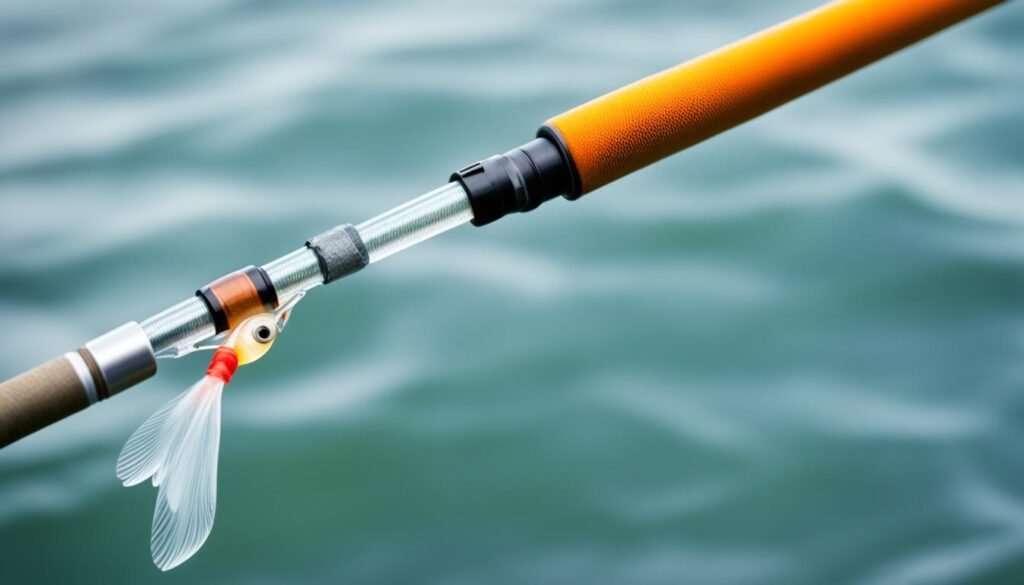
Deciphering Crappie Lures and Baits
The choice of lures and baits is a crucial factor that can greatly influence your success in crappie fishing. By understanding the different types of lures and baits available, you can make informed decisions and increase your chances of landing a prized crappie.
One popular choice for crappie fishing is using jigs. Jigs are versatile and can be effectively used in various fishing techniques such as jigging and casting. These lures mimic the movement of natural prey and entice crappie to strike. Jigs come in a wide range of colors, sizes, and designs, allowing you to match the fishing conditions and the behavior of the crappie.
Another effective option is using crankbaits and spinners. These lures are especially useful when crappie are in an aggressive feeding mood. Crankbaits imitate injured baitfish, while spinners generate attention with their spinning blades. When using crankbaits and spinners, consider experimenting with different colors and retrieve speeds to find the most enticing presentation for crappie.
Pro Tip: Jigging Techniques
Jigging is a popular technique for targeting crappie. To effectively jig for crappie, cast your jig near structures such as fallen trees, brush piles, or weed beds. Allow the jig to sink to the desired depth and then use a twitching or hopping motion to simulate the movement of prey. Mid-depths are often productive for crappie, so experiment with various jigging depths until you find success.
Pro Tip: Crankbaits for Aggressive Crappie
If you notice that crappie are actively feeding and displaying a more aggressive behavior, crankbaits can be highly effective. Crankbaits with a realistic design and natural swimming action can trigger a reaction strike from crappie. Focus on areas with ample cover, such as submerged structure or drop-offs, and vary your retrieve speed to find the rhythm that entices the fish to strike.
Adapting Your Crappie Fishing Setup for Different Techniques
Crappie fishing offers a variety of techniques to suit different fishing conditions and preferences. Adapting your fishing setup to these techniques can significantly enhance your chances of success on the water. Two popular techniques for targeting crappie are vertical jigging and trolling.
Vertical Jigging
Vertical jigging is a classic crappie fishing technique that involves precisely presenting a jig vertically in the water column to entice crappie to strike. To start, select a jig with the appropriate weight for the depth you’re fishing and the current conditions. Attach the jig to your line, lower it into the water, and let it sink to the desired depth.
Once the jig reaches the target depth, begin slowly lifting and dropping the rod tip in a controlled manner. This motion imparts an enticing action to the jig, making it appear like a struggling baitfish. Keep an eye on your line and rod tip for any signs of a bite, which can often be subtle. When you feel a bite or notice a sudden slack in the line, set the hook with a quick upward motion of the rod.
Trolling
Trolling is another effective technique for crappie fishing, particularly when covering a larger area or locating active schools of fish. To begin trolling, set up multiple rods equipped with different lures in varying colors and types. This allows you to experiment and find out what the crappie are actively biting on that day.
When trolling, maintain a steady boat speed, typically around 1 to 2 miles per hour. This speed is appropriate for crappie and allows the lures to move naturally through the water. Pay attention to your rod tips for any hints of a strike, and be ready to set the hook when necessary.
Remember, crappie can be selective at times, so it’s essential to vary your trolling speed, lure colors, and depths until you find a combination that triggers their aggression.
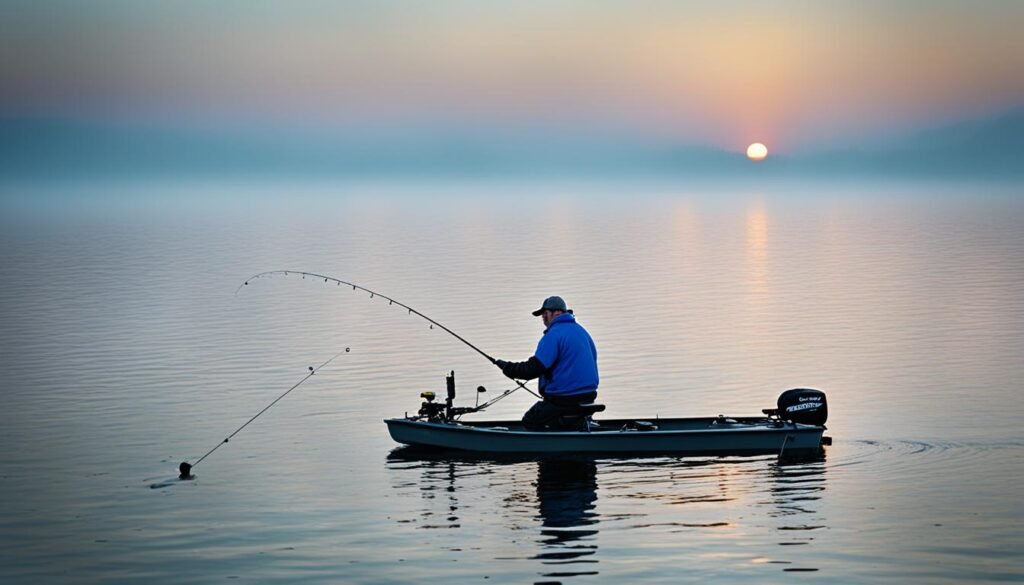
Adapting your crappie fishing setup to techniques like vertical jigging and trolling significantly increases your chances of a successful catch. These techniques offer different approaches to target crappie in various fishing scenarios, allowing you to adapt and find what works best on any given day.
Fishing for Crappie on a Budget
Fishing for crappie is a fun and rewarding activity, but it doesn’t have to break the bank. With a budget-friendly crappie fishing setup, you can enjoy the thrill of catching these popular game fish without spending a fortune. In this section, I’ll share some tips on how to put together an affordable setup that doesn’t compromise on quality or performance.
Choosing Affordable Rods and Reels
When it comes to selecting rods and reels for crappie fishing on a budget, there are a few reliable brands that offer excellent value for money. Two popular options are Ugly Stik and Shakespeare. These brands provide a range of affordable yet durable rods and reels that are well-suited for crappie fishing. Their products may not have all the bells and whistles of high-end gear, but they get the job done without compromising on performance.
Here are a few budget-friendly rod and reel options that you can consider:
- Ugly Stik GX2 Spinning Combo
- Shakespeare Ugly Stik Elite Spinning Rod
- Shakespeare Crappie Hunter Spinning Combo
These rods and reels offer good sensitivity and strength, allowing you to feel the subtle bites of crappie while providing the necessary power to reel them in.
Affordable Fishing Lines
When it comes to fishing lines, there are affordable options that don’t sacrifice performance. Two recommended lines for crappie fishing are Trilene Sensation and PowerPro. Trilene Sensation is a monofilament line that offers excellent visibility and strength. PowerPro, on the other hand, is a high-quality braided line known for its durability and sensitivity. Both lines are available in various pound test strengths, allowing you to choose the right one for your crappie fishing setup.
Summary
Fishing for crappie on a budget is entirely possible with the right gear. By opting for budget-friendly rods and reels like those offered by Ugly Stik and Shakespeare, you can enjoy a reliable and effective setup without breaking the bank. Pair these affordable options with lines such as Trilene Sensation or PowerPro, and you have a budget-friendly crappie fishing setup that will help you reel in those prized catches.
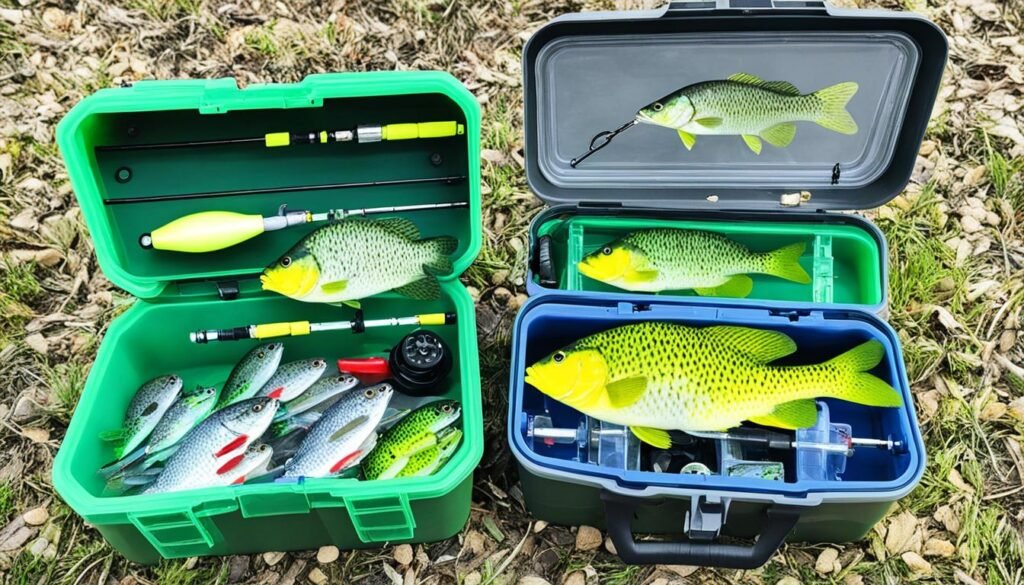
| Rod and Reel | Price Range |
|---|---|
| Ugly Stik GX2 Spinning Combo | $40 – $60 |
| Shakespeare Ugly Stik Elite Spinning Rod | $25 – $40 |
| Shakespeare Crappie Hunter Spinning Combo | $30 – $50 |
Conclusion
In conclusion, optimizing your crappie fishing setup is essential for increasing your chances of success on the water. By carefully selecting the right gear, understanding the basics of crappie fishing, and adapting your techniques to different conditions, you can enhance your overall fishing experience and catch more crappie.
When it comes to the optimal crappie setup, it’s important to choose a fishing rod that strikes the right balance between sensitivity and strength. A medium to ultra-light power rod around 7 to 9 feet in length, made of lightweight and sensitive graphite material, is ideal for accurate casting and handling the fight of the crappie.
Pairing your rod with the perfect reel is also crucial. Look for a reel with a moderate gear ratio of around 6:1 for a steady retrieve, and a reliable drag system that can handle the powerful runs of a crappie on the line. Additionally, don’t overlook the importance of selecting the right fishing line. Monofilament in the 4 to 8-pound test range offers the right balance of visibility and strength.
Lastly, mastering different fishing techniques can greatly improve your crappie fishing success. Experiment with jigs, crankbaits, and spinners to entice crappie to strike. Learn the art of vertical jigging and try trolling with multiple rods and various lures to adapt to different fishing conditions. By incorporating these fishing tips and techniques into your crappie fishing repertoire, you’ll be well on your way to a rewarding and fruitful fishing experience.
